By P. Jenniskens and T. Cooper
Abstract: The Volantid meteor shower was again detected by southern hemisphere CAMS networks on 2020 December 27–28 after not having been seen since their discovery by the CAMS New Zealand network in 2015. Following this initial announcement, the shower gradually increased in intensity and peaked on New Year’s Eve at 12h UT. The shower was detected until 2021 January 3 and behaved much like in 2015. Median orbital elements for the 2020-2021 return are presented. Visual observations under Moon-lit conditions confirmed the activity.
1 Introduction
The Volantid meteor shower was discovered by the CAMS video network in New Zealand during the night of 2015 December 31 (Jenniskens et al., 2016) and was confirmed by VHF radar observations that recorded the shower for several additional days when the New Zealand CAMS stations were clouded out (Younger et al., 2016). The meteors radiated from the constellation Volans, the flying fish.
The meteor shower was not detected in the following years, but it re-emerged on 2020 December 27 and 28, when the southern hemisphere CAMS networks spotted the first Volantids of this return. A CBET telegram was published and observers were alerted in order to facilitate targeted observations to cover this event. The activity was expected to intensify and to last for a number of nights if the shower would behave in the same way as in 2015 (Jenniskens, 2020; 2021a).
Here, we report on subsequent observations of the shower, which confirm that the shower returned much like in 2015. The shower peaked on New Year’s Eve.

Figure 1 – The Volantid radiants (marked in blue) detected among the meteoroid orbits collected by the CAMS networks between 2020 Dec. 28.0 ± 0.5 and 2021 Jan. 02 ± 0.5 UT. The nearby white points are likely also Volantids, but with orbits measured slightly different from those of the 2015-detected shower members.
2 Results 2020–2021
The 2020 – 2021 Volantids were detected by the CAMS networks in New Zealand (J. Baggaley), Australia (M. Towner), South Africa (T. Cooper), Namibia (T. Hanke), and Chile (S.Heathcote and E. Jehin). The activity period covered 2020 December 27 until 2021 January 3 (Figure 1).
The meteor shower peaked at λʘ = 280.0 ± 0.1° or 2020 December 31 at 12h UT (equinox J2000.0). The full-width-at-half-maximum of the shower was 1.6 ± 0.2°, which corresponds to 38 ± 5 hours (Figure 2). In total 247 triangulated meteors resulted in valid orbits of the Volantid meteor shower, detected over the solar-longitude range 271.95° – 283.91°. Most were faint, with a magnitude distribution index of 3.8 (+0.6/-0.1) (Jenniskens 2021b).

Figure 2 – Volantid shower rates as a fraction of the rate of observed sporadic meteors during each night. Lines are the best-fit exponential and Lorentzian curves.
Table 1 presents the median radiant and orbit parameters obtained during this season. Results are compared to those obtained during the discovery of the Volantids in 2015–2016. Errors give the apparent 1-sigma dispersion in the measurements based on 21 meteors observed during a short time interval in 2015 and the 247 meteors detected this year. There is good agreement, confirming that this is a return of the Volantids. There is no known parent body.
Table 1 – The median radiant and orbit of the Volantid meteor shower for the discovery year and during the first return of the shower.
| 2015–2016 | 2020–2021 | |
| λʘ | 279.27° | 280.0 ± 0.1° |
| αg | 122.9 ± 4.7° | 123.3 ± 4.9° |
| δg | –71.9°± 1.9° | –71.9 ± 2.3° |
| vg | 27.4 ± 1.5 km/s | 30.4 ± 2.2 km/s |
| a | 2.23 AU | 2.84 AU |
| q | 0.975 ± 0.004 AU | 0.974 ± 0.005 AU |
| e | 0.562 ± 0.093 | 0.657 ± 0.125 |
| i | 47.8 ± 2.0° | 50.6 ± 2.9° |
| ω | 347.7 ± 3.4° | 347.7 ± 3.6° |
| Ω | 99.256 ± 0.066° | 98.8 ± 1.7° |
| Π | 87.0 ± 3.4° | 86.5 ± 3.6° |
| Q | 3.5 ± 0.9 AU | 4.7 AU |
| P | 3.3 Y | 4.8 Y |
| TJ | 3.06 | 2.54 |
Visual observations were conducted by Tim Cooper, Astronomical Society of Southern Africa, from Bredell, South Africa, for a 3.6-hour period 2020 Dec. 29d21h00m–30d00h12m (λʘ 278.330° –278.466°), with a limiting magnitude of 5.2 and Full Moon, with some scattered clouds, and the radiant rising from altitude 35.8° to 45.5°. Under these circumstances a total of three Volantids and six other meteors were seen, which corresponds to an average Zenith Hourly Rate (ZHR) of 7.9 ± 4.5 Volantids per hour. The night of December. 30–31 was overcast all night. The night of December 31–January 1 (λʘ 280.284° – 280.461°) yielded again three visual Volantids and five other meteors during 2.75 hour of observations under similar observing conditions, resulting in a ZHR = 11.2 ± 6.5 meteors/hour.
We conclude that the Volantids returned in 2020 much like they were seen in 2015. The new shower was the most prominent meteor shower in CAMS data (on both hemispheres) from 2020 December 30 to 2020 January 1 (see those dates at the CAMS website http://cams.seti.org/FDL/). On New Year’s Eve, many firework displays were curtailed due to the COVID pandemic, but observers on the southern hemisphere could enjoy an unusual natural meteor shower.
References
Jenniskens P., Baggaley J., Crumpton I., Aldous P., Gural P. S., Samuels D., Albers J., Soja R. (2016). “A surprise southern hemisphere meteor shower on New-Year’s Eve 2015: the Volantids (IAU#758, VOL)”. WGN, Journal of the International Meteor Organization, 44, 35–41.
Jenniskens P. (2020). “Volantid meteors 2020”. CBET 4901, 2020 December 29.
Jenniskens P. (2021a). “Return of Volantid meteor shower, expected to peak on New Year’s Eve”. eMetN, 6, 22–23.
Jenniskens P. (2021b). “Volantid meteors 2020”. CBET 4923, 2021 January 24.
Younger J., Reid I., Murphy D. (2016). “Radar observations of the Volantids meteor shower”. In, Roggemans A. and Roggemans P., editors, Proceedings of the International Meteor Conference, Egmond, the Netherlands, 2-5 June 2016. IMO, pages 352–357.

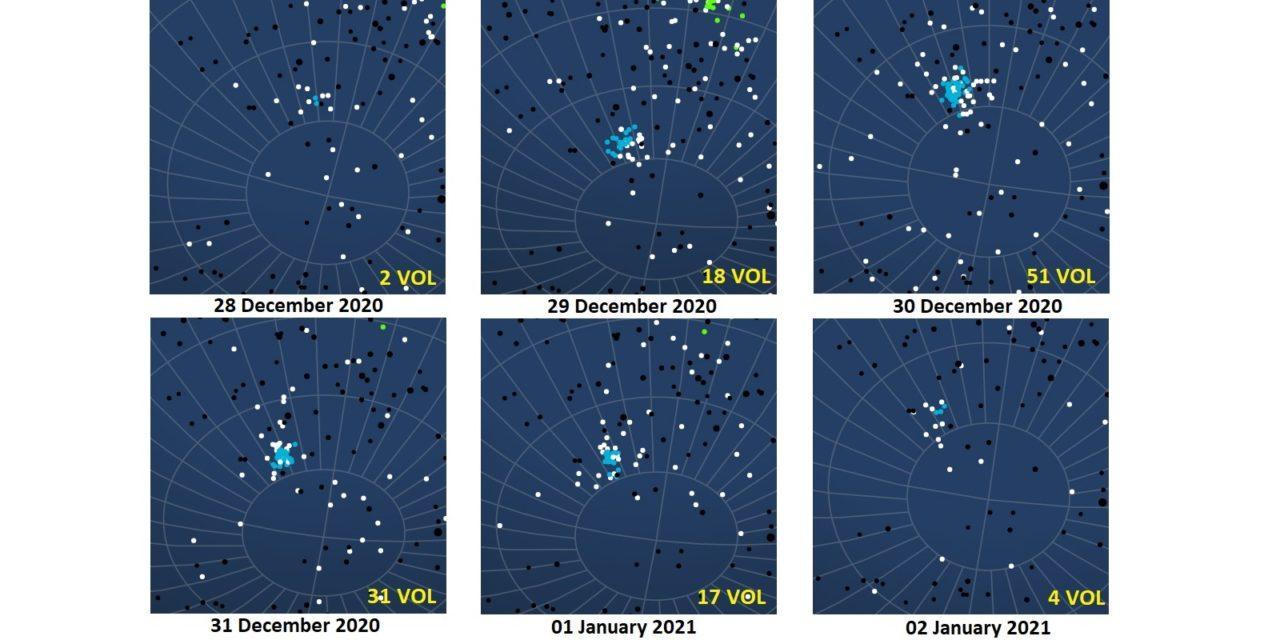
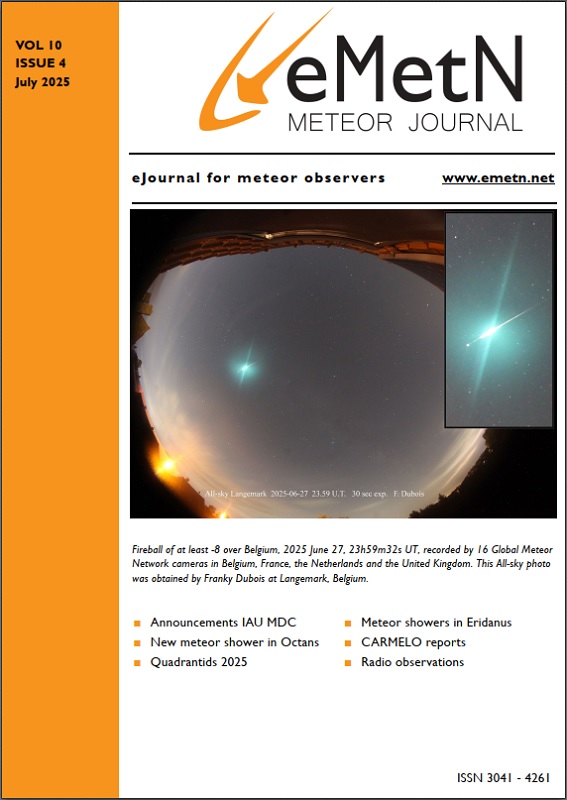
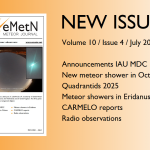
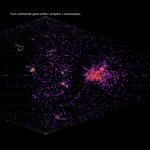
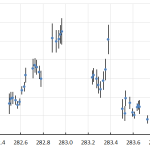
Hello Dr.Jenniskens !
Clusters of white radiant dots near VOL look suspicious. Maybe the white dots are not sporadic radiant, but an optical superposition of another meteor shower? Have you checked the velocity range for the white dots near the blue radiant VOL?
Best regards, I.Sergey